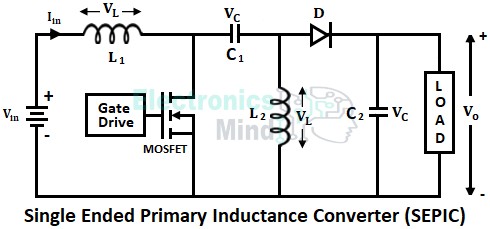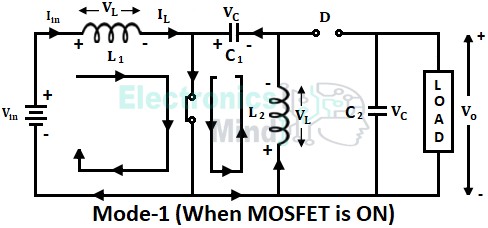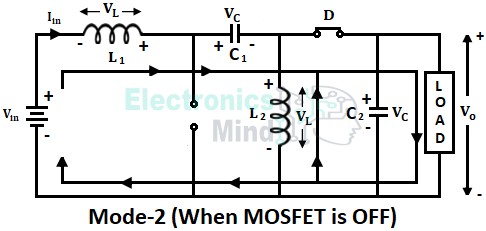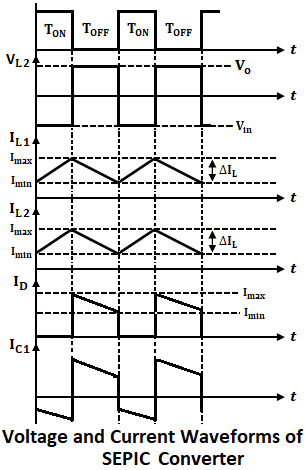What is SEPIC Converter?
SEPIC stands for single-ended primary-inductor converter. SEPIC is basically a type of dc-to-dc converter which allows a range of dc voltage at its input side and gives a stable voltage at the output side. This type of converter is quite similar to buck-boost and Cuk converters which provide an output voltage greater than, less than, or equal to its input voltage.
Similar to the buck-boost converter SEPIC converter uses the functions of a buck and boost converter. Compared to the buck-boost converter, a SEPIC converter offers some advantages like the polarities of the input and output voltages being the same, high efficiency, and the capacitor isolating the input and output side.
Circuit Diagram of SEPIC Converter :
The schematic diagram of a basic single-ended primary-inductor converter (SEPIC) is shown in the below figure. Similar to buck-boost and Cuk converters SEPIC converter also uses inductors and capacitors in order to obtain the regulated output.
The circuit consists of two inductors, two capacitors, and two static switches. Static switches are basically semiconductor devices in which one will be a diode and another will be typically a transistor (MOSFET or IGBT or BJT). The diode will be an uncontrolled switch that will turn ON and OFF automatically depending upon the voltage across it.
Due to higher input impedance and lower voltage drop, MOSFET is preferred over IGBT and BJT in most of the dc-to-dc converters. MOSFET will be controlled by controlling the gate terminal using PWM signals.
Working of SEPIC Converter :
When the MOSFET is switched ON by applying gate pulse, the source current starts flowing through the inductor L1, MOSFET, and back to the source as shown below. This causes the inductor’s current IL1 to increase and thus inductor will start charging from the input source.
When the inductor L1 is in charing, the instantaneous voltage VL1 of inductor L1 will be approximately equal to the source voltage Vin. Also when MOSFET is ON, the inductor L2 is charged by energy released by the capacitor C1. The capacitor C1 will dissipate its energy to inductor L2 through the MOSFET as shown above.
Now once the MOSFET is turned OFF by removing the gate pulse, the inductor L1 doesn’t allow a sudden change in current and the polarity of the inductor reverses according to the Lenz law. Thus the inductor will start discharging in the reverse direction and supplies its energy to the capacitor C1 as shown below.
The capacitor C1 which was discharged when MOSFET is turned ON will be charged by inductor L1. Consequently, the charged inductor L2 will also start discharging in the reverse direction due to which the diode gets forward biased, and the energy dissipated from the inductor L2 will be transferred to the load.
Again when the MOSFET is switched ON, the cycle again repeats i.e., the inductors L1 and L2 will be charged by source and capacitor C1 respectively. The SEPIC converter can be operated either in discontinuous conduction mode or continuous conduction mode depending upon whether the current through either of the inductors is made to fall to zero or not. The below shows the current and voltage waveforms.
Advantages of SEPIC Converter :
- In buck-boost and Cuk converters the polarity of the output voltage will be opposite of the input voltage i.e., an inverted output voltage will be obtained. Whereas in SEPIC the polarity of the output voltage will be the same as the input voltage.
- The capacitor C1 will isolate the input and output sides from each other i.e., an abnormal condition occurring on any side of the circuit will not affect the other side.
- Reduced input current ripple.
- Cuk and buck-boost converter operation cause a large amount of electrical stress on the components which can be overcome in SEPIC.
- High efficiency and stable operation.
- The use of coupled inductor instead of two inductors (two inductors wound onto the single core) makes the circuit compact.
Disadvantages of SEPIC Converter :
- Similar to the buck-boost converter, the output current of SEPIC can be pulsating. Whereas in the Cuk converter the output current is continuous.
- All the current from the source to load has to go through capacitor C1, thus a capacitor of high capacitance and current handling capability is required.
- Since the voltage across the capacitor C1 reverses for every cycle it should be of a non-polarized type.
Applications of SEPIC Converter :
- DC power supply systems with unregulated inputs.
- Battery-operated equipment.
- Lighting applications.




